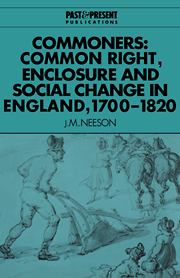Book contents
- Frontmatter
- Contents
- List of tables
- Preface
- Introduction
- 1 The question of value
- I SURVIVAL
- 2 Who had common right?
- 3 Threats before enclosure
- 4 Ordering the commons
- 5 Enforcing the orders
- 6 The uses of waste
- II DECLINE
- III CONCLUSION
- Appendix A Using the Land Tax
- Appendix B Acreage equivalents
- Appendix C Correcting and editing the Land Tax
- Appendix D Landholding estimates
- Bibliography
- Index
- Past and Present Publications
6 - The uses of waste
Published online by Cambridge University Press: 01 February 2010
- Frontmatter
- Contents
- List of tables
- Preface
- Introduction
- 1 The question of value
- I SURVIVAL
- 2 Who had common right?
- 3 Threats before enclosure
- 4 Ordering the commons
- 5 Enforcing the orders
- 6 The uses of waste
- II DECLINE
- III CONCLUSION
- Appendix A Using the Land Tax
- Appendix B Acreage equivalents
- Appendix C Correcting and editing the Land Tax
- Appendix D Landholding estimates
- Bibliography
- Index
- Past and Present Publications
Summary
I always admire the kindling freshness that the bark of the different sorts of tree and underwood asume in the forest – the ‘foul royce’ twigs kindling into a vivid color at their tops as red as woodpigeons claws the ash with its grey bark and black swelling buds the Birch with its ‘paper rind’ and the darker mottled sorts of hazle black alder with the greener hues of sallows willows and the bramble that still wears its leaves with the privet of a purple hue while the straggling wood briar shines in a brighter and more beautiful green odd forward branches in the new laid hedges of white thorn begin to freshen into green before the arum dare peep out of its hood or the primrose and violet shoot up a new leaf thro the warm moss and ivy that shelter their spring dwellings the furze too on the common wear a fairer green and here and there an odd branch is coverd with golden flowers and the ling or heath nestling among the long grass below is sprouting up into fresh hopes of spring the fairey rings on the pasture are getting deeper dyes and the water weeds with long silver green blades of grass are mantling the stagnant ponds in their summer liverys.
The fuel, food and materials taken from common waste helped to make commoners of those without land, common-right cottages, or pasture rights.
- Type
- Chapter
- Information
- CommonersCommon Right, Enclosure and Social Change in England, 1700–1820, pp. 158 - 184Publisher: Cambridge University PressPrint publication year: 1993

